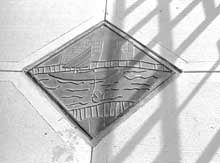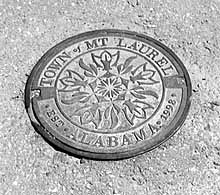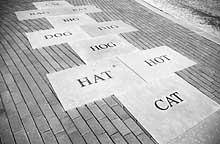
VOL. 5, NO. 2 -- SPRING 2003
Use Your Feet: The Art of Walking
Walking is a central experience in new urban communities. Whether a five-minute
walk to the corner store, a quick jaunt to the transit stop, or a leisurely
stroll for a teenager to a friend's house, walking is incorporated into
every successful urban and new urban place. Several diverse communities
are literally using the ground we walk on as a canvas for public art projects.
These sidewalk medallions, manhole covers and pavement inserts engage
us in our walking environment to provide delight and whimsy, reinforce
the special identity of a place, and reflect the many layers of our urban
experience.
In
downtown Milwaukee, Wis., bronze medallions embedded in the sidewalks
provide markers and an urban pathway for walkers along the riverfront.
Completed with a percent for art program in the mid-1990s and administered
through the riverfront redevelopment agency and public art board, the
medallions feature children's drawings cast in bronze. Students at a local
school completed drawings that reflect the children's interpretations
of the river in their city. A local artist cast the drawings into the
bronze medallions that were then installed into the sidewalk pavement.
The medallions, which can be followed along the majority of the riverfront,
are a simple and fun way to increase the audience for art. In the case
of Milwaukee, the success of the medallions and the success of the riverfront
revitalization have led to additional, larger-scale public art projects
including gateway pieces and temporary art exhibitions held during the
summer months.
In
Mt. Laurel, Ala., a simple investigation into a custom-designed manhole
cover turned into an interesting functional, yet decorative element for
the streets and potentially the sidewalks of this new town. Developer
Ebsco Realty worked with East Jordan Iron Works to create a custom mold
for its manhole covers. For a small additional set-up charge, the foundry
cast the covers with the design of the town seal. Used primarily in the
streets, the manhole covers have also become decorative items, with some
residents making tables out of the covers. While simple in execution,
these manhole covers recall the innovative 1970s program in Seattle, Wash.,
where citizens could personally donate artist-designed elements such as
manhole covers, fountains, benches and other items to their urban neighborhood.
Naturally, these items help to increase neighborhood identity and promote
residents' pride.
Sometimes walking involves waiting -- waiting at a
stoplight, waiting for the bus or trolley, or waiting at the transit stop
for the train home. In Portland, Ore., along the length of the Westside
Light Rail Project, several public art projects take advantage of the
captive audience of a passenger waiting for a train. Commissioned through
a percent for art program managed by the Westside MAX Art Advisory Committee,
many of the integrated public art projects are in, over or under the transit
station's platform. Planners and designers like to use site-specific projects
to reinforce identify of a place and contribute to the neighborhood's
connection to transit. When many of the template-designed elements are
repeated throughout a project, artist-designed enhancements create unique
remembrances. At the Willow Creek/SW 185th Transit Center, the design
team created word puzzles that act as rugs or carpets under the light
rail shelters.
Wachovia's new pocket park project, "The Green," features game boards embedded along the brick-paved pathway through the park. Located in downtown Charlotte, N.C., headquarters for the newly merged First Union and Wachovia Banks, the urban park is constructed over a parking garage and integrates ground-floor retail, office and residential development. The public art projects incorporate whimsical and fun interactive games centered on the themes of reading and literature as a complement to Wachovia's corporate commitment to public education and early childhood literacy. Nationally known public artist Carolyn Braaksma designed a hopscotch board with words that change with the addition or deletion of one letter. The games, sometimes riddles or word transformations, challenge the occasional visitor, spark the imagination of children and engage many a walker in the park.


